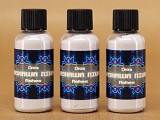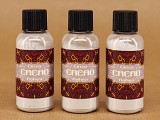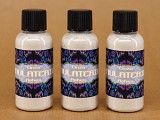Pot, 60 Ml, 35 Gr from Brazil (SKU 4945)
A rare opportunity to obtain ashes from a remote tribe, the Kulina. The ashes are from the Murici (Byrsonima crassifolia). Traditionally a tea is made with the bark. The ash is a bit greyer than other tribes burn them. A potent and very original product, Kulina ashes mix excellently with any of the Tabacos. Furthermore, blending Tabaco with ashes increases the strength and absorption, making it exquisitely strong. More information below.
Packed in 60 ml clear plastic pots containing 35 gr.
| change currency | |||||||||
| SKU | Part | Volume | Weight | Unit | Price | Qty
|
|||
|---|---|---|---|---|---|---|---|---|---|
| 4943 | bottle | 10 ml | 6 gr | 1 pc | $ 5.29 | ||||
| 4944 | bottle | 25 ml | 15 gr | 1 pc | $ 11.34 | ||||
| 4945 | pot | 60 ml | 35 gr | 1 pc | $ 22.04 | ||||
A rare opportunity to obtain these ashes from a remote tribe, the Kulina. Their rapé is not very well known and is mostly made for their own use. These ashes we managed to get are from the Murici (Byrsonima crassifolia). The ash is a bit greyer than other tribes burn them. A potent and very original product.
Byrsonima crassifolia is a slow-growing, very ornamental, semi-deciduous shrub or small tree with a rounded, generally sparse crown; it can grow up to 10 metres tall. Known locally by indigenous people as Mirixi Vermelho (red Mirixi). The bark is rich in tannins.
For more information, refer to the full article here.
A detailed description on how to blend your own Rapé can be found here.
Scientific name: Byrsonima crassifolia
Part used: Wood, bark
Region of origin: Tarauaca, Acre state
Method of processing: Naturally fallen wood is burned into pure ashes and sieved.
Made by the Kulina community.
Appearance: Ash
Colour: Light grey
Odour: Indistinct
Taste: Indistinct
Expiry date: Indefinite
Uses: Natural preparations, incense, ceremonial use
Other names: Murici Ashes
The Kulina are a tribe from the Acre and southern Amazonas region. Nowadys they all live in Amazonas state but close to the border with Acre and have contact with some tribes. They are not from the Pano linguistic root but Arawá. They call themselves Madija (Madirra) meaning "those who are people". An interesting observation is that many of the indigenous groups refer to themselves as people or real people, like de Huni Kuin or Noke Koi. The Kulina live very isolated, and their culture and language are more intact than many of the other tribes of the region. Most Kulina don't speak Portuguese. Their tribe mystics are very respected by the other tribes of the region and are of a different type. They don't wear beautiful feathers or play guitar, but their knowledge is on another level.
BATISTA, Ana Cristina Borges. Kulina. In: GONÇALVES, Marco Antônio Teixeira (Org.). Acre : história e etnologia. Rio de Janeiro : Núcleo de Etnologia Indígena/UFRJ, 1991. p. 145-76.
CHANDLESS, W. Ascent of the river Purus. Journal of the Royal Geographical Society, Londres, v.36, 1866.
DEICKE, Nelson. Madija : resistindo a partir da cultura. Cadernos Comin, São Leopoldo : Comin, n. 3, 18 p., fev. 1994.
ERIKSON, Philippe et al. Kirinkobaon kirika (“Gringos’ Books”) : an annotated panoan bibliography. Amerindia, Paris : A.E.A., n. 19, 152 p., supl., 1994.
FUNDAÇÃO DE CULTURA E COMUNICAÇÃO ELIAS MANSOUR; CIMI. Povos do Acre : história indígena da Amazônia Ocidental. Rio Branco : Cimi/FEM, 2002. 58 p.
MONTEIRO, Rosa Maria. “Vamos acabar nosso trabalho!” : a demarcação da Área Indígena Kulina do Médio Juruá. In: KASBURG, Carola; GRAMKOW, Márcia Maria (Orgs.). Demarcando terras indígenas : experiências e desafios de um projeto de parceria. Brasília : Funai/PPTAL/GTZ, 1999. p.155-66.
POLLOCK, Donald. Culina shamanism : gender, power and knowledge. In: LANGDON, E.J. (ed.). The portals of power : shamanism in South America. s.l. : Univers. of New Mexico Press, 1992.
This natural product is offered for its ethnographic and historical value and is delivered with no expressed or implied fitness for a specific purpose. It is simply a raw botanical specimen, or a scientific sample. The information provided is purely meant for historical, scientific and educational purposes and should never be interpreted as a recommendation for a specific use. The use and application of our product is at the customer's decision, responsibility and risk.
Read our Terms & Conditions for more details.
















